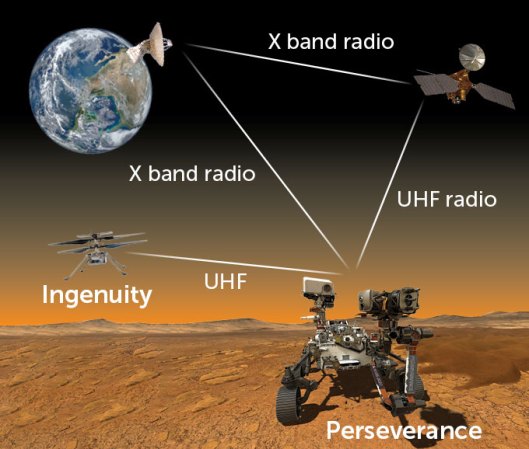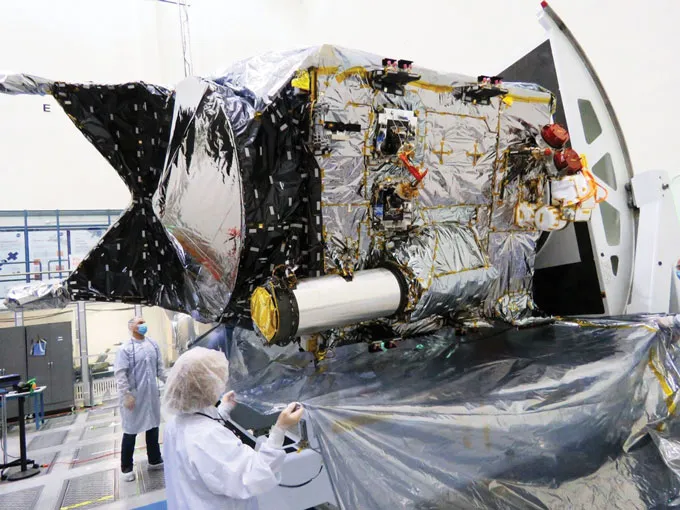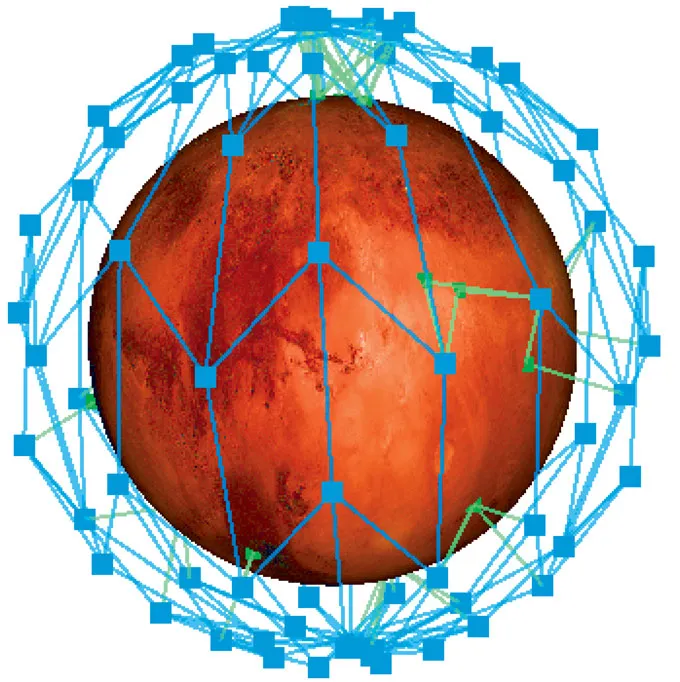How to build an internet on Mars
Future Red Planet inhabitants will need new and improved ways to connect

Today's communications infrastructure couldn't support the needs of future Mars inhabitants.
GLENN HARVEY
When astronauts land on Mars, a couple of decades from now, perhaps, they’ll need to find a way to communicate — with each other, with equipment on and around the planet, and with mission control back on Earth. Despite living so far from home, they’ll no doubt want to connect with loved ones, keep their playlists up-to-date or stream the latest episodes of their favorite shows.
But setting up a Wi-Fi connection to Earth’s internet won’t be an option. Earth is simply too far away — around 55 million to 400 million kilometers, depending on where the planets are in their orbits. Spacefarers will need another strategy.
Establishing a good communications infrastructure is essential for human missions to Mars, says Claire Parfitt, a systems engineer with the European Space Agency, or ESA, who is based in Noordwijk, Netherlands. “At the moment, we’re in the early stages of working out what that means.”
Researchers are testing ways to upgrade existing networks, along with some far-out alternatives. For example, NASA’s Psyche mission, which lifted off in October with the job of exploring an asteroid between Mars and Jupiter, will also test interplanetary communication using lasers. Lasers could carry far more data than the radio waves that have been used from the earliest days of space travel.
No known strategies can get rid of the time lag in communications between Earth and Mars; a message moving at the speed of light takes anywhere between four and 24 minutes for a one-way trip. In other words, a quick ping to mission control is out of the question, not to mention a WhatsApp call home.
There’s also the issue of solar conjunction, says Parfitt, when the sun comes between Earth and Mars. This happens for a couple of weeks every two years or so, cutting off communications between the planets. The last one took place in November.
But new approaches could open possibilities that make communications on Mars more akin to what we experience here on Earth. At least one research team has wondered: What if Mars had its own internet?
How Mars communication works today
Several space agencies have landers, rovers and satellites already at Mars that have to communicate with Earth.
Consider NASA’s Perseverance rover. It sends and receives two kinds of information. One is command and telemetry, where operators on Earth send instructions, receive information and make decisions on what to do next. Percy typically receives over 1,000 commands from Earth every day. The second is the science data — pictures of Martian rocks, for example — that Percy collects. The helicopter Ingenuity, which ended its mission earlier this year, also regularly pinged the rover, which served as a base station to relay data and commands between Ingenuity and Earth. Orbiters circling the planet, including NASA’s Mars Odyssey and Mars Reconnaissance Orbiter, or MRO, and ESA’s Trace Gas Orbiter, or TGO, similarly send science data back home.
Calling Earth
Perseverance and other Mars rovers get most commands directly from Earth via X band radio waves. Though Percy can send small amounts of data directly, it often uses ultrahigh-frequency, or UHF, radio waves to transmit data to one of the orbiters in the Mars Relay Network, which have big antennas for sending data to Earth. Percy also served as a base station for communication with the helicopter Ingenuity.

A lot of the communication with Mars is routed through the Mars Relay Network in what NASA describes as “a tightly choreographed dance.” This network of five orbiters around Mars — MRO, TGO, MAVEN, Mars Odyssey and Mars Express — transmits information via antennas pointed toward Earth.
A rover that needs to send its latest observations back to Earth first passes the data along to one of the orbiters using ultrahigh-frequency radio transmissions. If that orbiter doesn’t have a line of sight to Earth, it can hold on to the information until it does. The data are then relayed toward Earth, where powerful radio antennas distributed across the globe are always listening for pings from deep space.
Once a human crew lands on Mars, this system will not be good enough. Vincent Chan, a researcher in fiber-optic and satellite communications at MIT, doesn’t foresee local, on-the-ground communication as a challenge. A Martian crew can interact using radio frequency and existing wireless technologies, he says. Two mini cell towers would be enough when the astronauts are close together, and a relay of some kind could be used when the astronauts are far enough apart that messages have to be sent over the horizon. People living in remote regions of Earth communicate in a similar way all the time. “Those services are already in play,” Chan says, and “very economical.”
A big antenna on the crew’s landing vehicle, pointed toward Earth, would probably be the very first infrastructure Martian explorers would set up, Chan says, but then things could get more challenging. When that ground-based antenna doesn’t have a direct line of sight, astronauts could use orbital relays akin to the Mars Relay Network to communicate with Earth. Several orbiters would have to be available for round-the-clock coverage, and they’d need to be optimized for heavy data transfer.
ESA is currently looking at making today’s relay network more robust. It is in the early stages of considering a concept called the Mars Communication and Navigation Infrastructure, or MARCONI. If it moves forward, the project will develop a set of communication- and navigation-related payloads that could piggyback on any mission headed to Mars.
Once deployed into orbit, these payloads would act as nodes to provide radio communication on and with Mars, Parfitt explains. They could then stick around for use on future missions. “The more mass you land, the more expensive it is, so you wouldn’t necessarily want to land massive communication systems on Mars every time,” she says.
Though traditional radio frequencies would suffice for low data rates, using a laser link could carry 10 to 100 times as much data in the same time frame. Because of the higher frequencies of optical waves, hundreds of thousands of times those of radio waves, much more information can be packed in. Thus, this type of optical signal is just where space communication may be headed.
Laser communication in space
The Psyche spacecraft, launched last October, will test the feasibility of long-distance laser communications as it heads toward Psyche, the metal-rich asteroid it’s going to explore. The spacecraft carries NASA’s Deep Space Optical Communications, or DSOC, technology.
Using lasers for space communication isn’t new, but they have never been tested from distances farther than the moon. In mid-November, Psyche beamed data to Earth from a distance of 16 million kilometers — 40 times farther than the moon. In December, it sent a video of a cat named Taters from 31 million kilometers away.

ESA is also exploring long-distance optical communication. One program called ScyLight, short for Secure and Laser Communication Technology and pronounced skylight, is supporting the research and development of optical and quantum technologies for secure and fast data communication from space.
Despite the benefits, optical communication requires ultraprecision in aiming the signal. Unlike radio communications, optical signals are sent in a narrow beam that has to point exactly at the receiver. What’s more, cloud cover and atmospheric effects also interfere with lasers.
Any shift toward optical communications would mean some upgrades to the existing radio antennas that listen for messages from deep space — called the Deep Space Network — or new infrastructure.
Though it’s closer than Mars, the moon offers learning opportunities for future connectivity. As part of the Artemis program, which aims to return humans to the moon, NASA has contracted private companies to set up a lunar 4G network for telecommunications. Such networks are based on radio waves and would include installing antennas and base stations that can withstand the harsh lunar landscape.
An ESA program called Moonlight invites private space companies to set up a constellation of communication satellites around the moon, including for regions that don’t have direct visibility to Earth. The first phase of the program includes the launch of the Lunar Pathfinder orbiter, currently planned for 2026.
“Everything that is being done for the moon, it’s got the objective of taking humans and missions to Mars,” says Tomas Navarro, who is based in London and is a future projects engineer with ESA.
An internet on Mars
Those Martian explorers, not to mention future inhabitants, will no doubt want to do more than send messages back and forth. They’ll want a setup akin to Earth’s internet, which we use for everything from sharing photos to accessing massive databases. In June 2023, Tobias Pfandzelter and David Bermbach of Technische Universität Berlin proposed that a fleet of satellites orbiting Mars could provide the Red Planet with its own offshoot internet.
Most of us here on Earth access the internet through our phones using radio-frequency radiation on either wireless 4G or 5G networks or through Wi-Fi routers. These connections are linked via fiber-optic cables around the world. The proposed Mars network would instead be similar to Starlink, a constellation of satellites in low Earth orbit operated by SpaceX. On Earth, broadband internet and mobile phone coverage via satellite is expensive, but on Mars, such a system might be cheaper and easier to build than an expansive and robust network on the ground.
Pfandzelter and Bermbach are both experts in cloud computing — the delivery of computing services over the internet. For their proposed Martian internet, they extrapolated concepts from edge computing, in which information is processed close to where it is collected.
Michael Clegg, a general manager at the technology company Supermicro, based in San Jose, Calif., has explained edge computing using the analogy of a popular pizza restaurant “that opens smaller branches in more neighborhoods, since a pie baked at the main location would get cold on its way to a distant customer.” Edge computing generally relies on base stations on the ground to store and relay the data, but low Earth orbit satellites are now being seen as an alternative.

Pfandzelter and Bermbach concluded that a constellation of 81 low-orbit satellites around Mars would be good enough for planetwide coverage. They would provide a local communications system that would be an extension of Earth’s internet.
Consider an astronaut on Mars trying to catch up on a Netflix show. “If you were to stream it from Earth, you would have to first wait 10, 15 or even 40 minutes,” Pfandzelter says, and that’s just to connect. It would be a frustrating stop-and-start affair. And if another astronaut on Mars wanted to watch the same movie, they have to go through the same process all over again.
Instead, a cloud data storage system on Mars could make movies easy to access. “You could just have the same experience that you have on Earth, because all your data is locally copied,” he says. Meanwhile, other uploads and downloads to and from Earth, such as science data, could continue in the background.
Putting internet satellites into orbit around Mars would also be economical because it wouldn’t require landing infrastructure on the surface; landing equipment can make up a big chunk of a mission’s budget. “It would be much cheaper to just send a bunch of networking satellites to Mars, and just keep them in orbit,” says Pfandzelter.
It’s similar to a scaled-up version of the MARCONI concept (and could use radio or optical waves, depending on the state of those technologies).
Even if arrival on Mars is decades away, Parfitt says, it’s not too soon to start planning. Live video-chatting between planets is out of the realm of scientific possibility. Unless there is a major upheaval in the laws of physics, messages won’t ever be able to travel faster than the speed of light. “It’s not a problem to be solved. It’s just a problem.”
But other limitations can be overcome. Tackling those challenges may not only benefit future astronauts on Mars but may also help get them there sooner.
“When you put in an infrastructure like that,” Parfitt says, “you see many, many more missions being proposed.”







